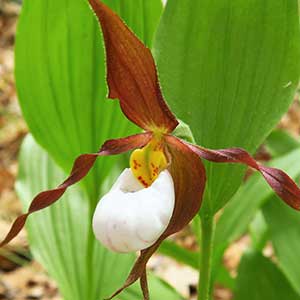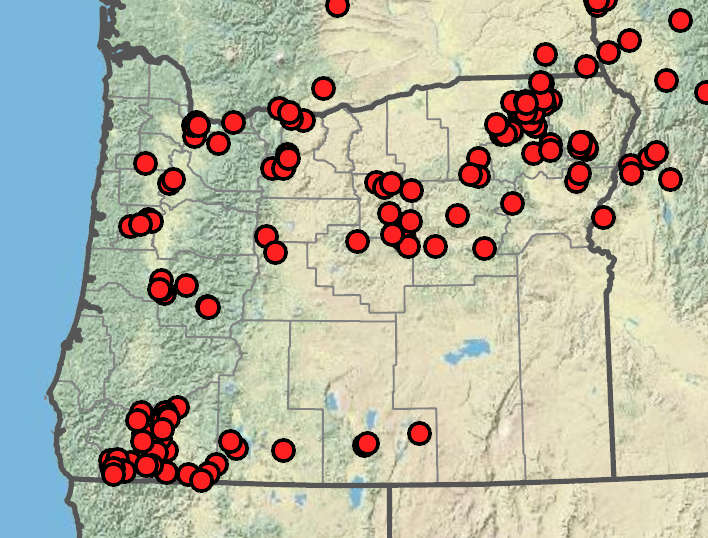Cypripedium montanum
Orchidaceae
mountain lady slipper
orchid family
alternate, 4–6, 8–17 × 4–10 cm.
simple;
basal, or cauline, alternate; opposite, or whorled, plicate; convolute, conduplicate, cylindric, or flattened;
margins entire, petioled or not;
stipules 0.
elongated, 1–3-flowered.
racemes; panicles; spikes, or rarely cymose;
flowers 1 to many; terminal or lateral, generally with bracts.
dorsal sepal lanceolate to ovate, 3–6 × 1–1.5 cm, green suffused with purple;
lateral sepals connate almost to tip, similar in color and shape to dorsal sepal;
petals linearlanceolate and twisted, 4–7 × 0.3–0.6 cm, purple;
lip 2–3 × 1.2–1.7 cm, white with purple spots inside.
bisexual, usually strongly bilaterally symmetric;
sepals 3, often petaloid;
petals 3, highly modified; central petal modified into lip;
stamens 1 or 2 (rarely 3); opposite lip, fused to style to form column;
pollen generally aggregated into 2–8 pollinia;
ovary inferior, 3-carpellate with 1 or 3 locules;
style fused to anther filaments;
stigma 3-lobed with middle stigma lobe modified into a small beak (rostellum).
capsules.
numerous; minute and dust-like, lacking endosperm.
Cypripedium montanum
Orchidaceae
Mixed conifer forests, open shrubby woodlands, roadsides. Flowering Apr–Jul. 50–2200m. BW, Casc, Col, CR, ECas, Sisk, WV. CA, ID, WA; north to AK. Native.
Cosmopolitan. Approximately 880 genera; 9 genera treated in Flora.
Achlorophyllous plants within this family are known to obtain nutrition from forest litter through fungal intermediates. Fungal association is crucial to seed germination and plant establishment and often persists for the life of the plant. The “lip” within flower descriptions refers to a central petal that is distinguished by its irregular, often larger, shape. Its purpose is to attract and serve as a guide to pollinators.
James Riser
- Local floras:
BC,
CA,
OR,
WA
- Local Web sites:
CalFlora,
CalPhotos,
Flora NW,
PNW Herbaria,
Turner Photog.
WildflowerSearch
iNaturalist (observations)
USDA Plants Database
- LBJ Wildflower Center
- SEINet
- Plants of the World Online
- Encyclopedia of Life
- Wikipedia
- Google Image Search
- Local floras:
CA,
OR
- Local Web sites:
CalFlora,
CalPhotos,
Flora NW,
PNW Herbaria
WildflowerSearch
iNaturalist (observations)
- LBJ Wildflower Center
- SEINet
- Plants of the World Online
- Encyclopedia of Life
- Wikipedia
- Google Image Search



